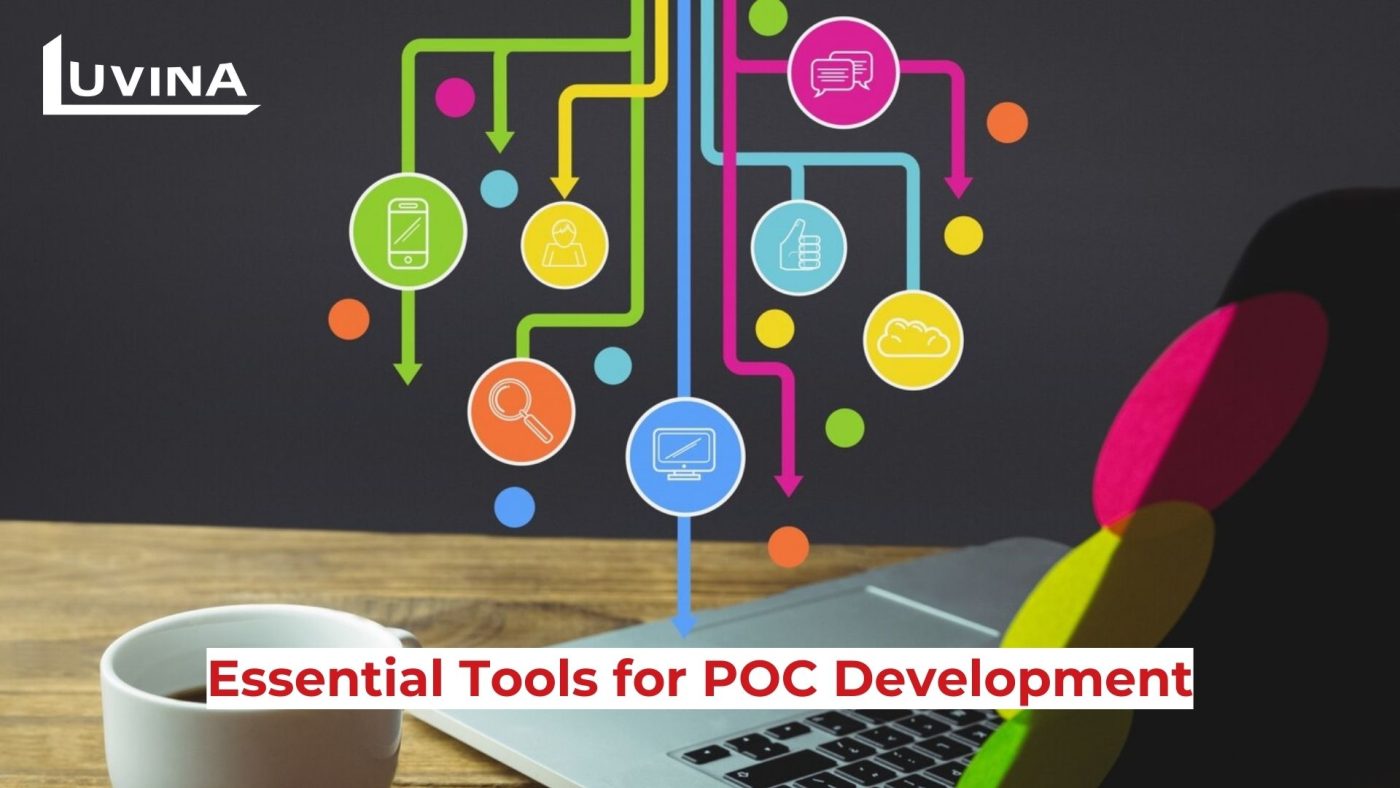What is POC in software development? Often heralded as the compass guiding software ventures, Proof of Concept (POC) software stands as a crucial phase in the journey from concept to reality. It’s the laboratory where nascent ideas are tested, honed, and sculpted into viable solutions.
In its essence, POC software encapsulates a limited version or prototype of an envisioned application. This miniature yet potent representation is meticulously crafted to illuminate the feasibility and viability of a concept or a specific facet of the software. It serves as the litmus test, affirming whether an idea holds the promise of success in the grander scheme of software development.
Let’s dive deeper into the essence of POC software, dissecting its core principles and unveiling the remarkable benefits it bestows upon innovative minds and aspiring projects.
What is POC in software development?
Proof of Concept (POC) software refers to a limited version or prototype of a software application developed to demonstrate the feasibility or viability of a concept, idea, or a specific aspect of the software.

Here are the key points about POC software:
1. Feasibility Testing: It’s created to validate a certain aspect of a larger software project, such as the functionality of a new feature, compatibility with specific systems, or potential market acceptance.
2. Limited Scope: POC software typically has a narrower focus and limited functionality compared to the final product. It aims to show that the core idea or technology works as intended.
3. Demonstration: Its primary purpose is to demonstrate to stakeholders, investors, or users that the proposed concept is viable and can be developed into a full-scale solution.
4. Quick Iteration and Testing: POCs are developed relatively quickly and are used for rapid testing and iteration. They help in identifying potential issues or challenges early in the development cycle.
5. Decision Making: POCs assist in organizational decision-making processes. Based on the results and feedback from the POC, decisions can be made on whether to proceed with further development or pivot the project.
6. Not Production-Ready: POC software is not intended for deployment or use in a production environment. It needs the robustness, scalability, and completeness of a final product.
Overall, proof of concept software serves as a preliminary model to showcase the viability and potential of an idea, allowing stakeholders to make informed decisions about future development or investment in a larger-scale software project.
Why do you need proof of concept software?
Exploring the multifaceted purpose of POC software offers a comprehensive view of how this critical phase drives project success and mitigates challenges.
1. Validating Feasibility
A fundamental goal of POC software is to ascertain the viability and feasibility of a new software idea. It allows stakeholders to test the practicality and potential success of the envisioned software in real-world scenarios. By creating a basic version of the software, developers aim to demonstrate the concept’s viability and feasibility, ensuring it aligns with the intended purpose and goals.
2. Testing Functionality and Features
During the POC phase, developers focus on creating a prototype that includes the core functionalities and features of the proposed software. This allows them to test and validate whether the software can perform its intended tasks effectively. It’s an opportunity to check whether the envisioned features align with the initial concept and whether they function as intended.
3. Gathering Feedback
POC software serves as a platform to gather invaluable feedback from potential end-users and stakeholders. Engaging these parties during the early stages of development provides critical insights into user expectations, preferences, and concerns. Their feedback guides improvements and iterations, ensuring that the final product aligns more closely with end-user needs and expectations.
4. Identifying Challenges and Risks
One of the key advantages of a POC is the ability to identify potential challenges, technical hurdles, or risks associated with the software idea. Early identification of such obstacles enables development teams to devise strategies to address them before moving forward with full-scale development. This proactive approach minimizes the chances of encountering major setbacks during the later stages of the project.
5. Determining Investment Worthiness
Ultimately, a well-executed POC serves as a litmus test to assess whether the software idea is worth further investment in terms of time, resources, and finances. Based on the results obtained during the POC phase, decision-makers can determine whether the software shows enough promise to warrant additional development efforts or if it requires reevaluation or possible abandonment.
By addressing these key points, a POC acts as a pivotal step in the software development process, providing valuable insights and guiding decisions regarding the future of the software idea.
Benefits of Leveraging a Proof of Concept (POC)
Utilizing a Proof of Concept (POC) in the software development journey yields multifaceted advantages. It not only serves as a cost-effective strategy for identifying and rectifying issues early on but also aids in refining the software’s design based on user feedback. Moreover, a well-executed POC minimizes risks and enhances stakeholder confidence, laying a solid foundation for successful software development endeavors.

1. Cost and Time Savings
A well-executed POC acts as an efficient diagnostic tool, identifying potential pitfalls, technical hurdles, or conceptual flaws at an early stage. By detecting and addressing these issues upfront, development teams save substantial resources—both in terms of time and budget. This proactive approach minimizes the need for costly overhauls or extensive rework during the later phases of software development.
2. User-Centric Development
Early-stage user feedback is pivotal in crafting software that aligns with user needs. A POC enables developers to present an initial version of the software to stakeholders and users, inviting constructive criticism and valuable insights. This early interaction allows for iterative improvements and adjustments based on user suggestions, thereby refining the software’s design, functionality, and usability.
3. Risk Mitigation
Deploying a POC serves as a prelude to the actual development phase, acting as a ‘trial run’ for the software. This enables teams to test critical functionalities, validate assumptions, and assess the software’s performance in a controlled environment. By identifying and rectifying potential issues before they escalate, a POC significantly reduces the risk of project failure or unexpected setbacks during full-scale development.
4. Boosts Stakeholder Confidence
Presenting a tangible demonstration of the software’s potential through a POC instills confidence among stakeholders and investors. A well-structured POC serves as a visual representation of the envisioned product, allowing stakeholders to comprehend its functionality and potential impact. This demonstration helps in garnering support, funding, and buy-in from key decision-makers, fostering a sense of assurance in the project’s feasibility and viability.
Tips for Proof of Concept (POC) Development Success
When embarking on a Proof of Concept (POC), its success hinges on a strategic approach encompassing various pivotal aspects. Here are fundamental tips that will steer you toward a triumphant POC:

1. Clearly Define Your Objectives
Before commencing the POC journey, delineate crystal-clear objectives. Ask yourself: What definitive outcomes do you wish to achieve through this endeavor? Defining these goals sets the trajectory for the entire POC development process, ensuring alignment and clarity.
2. Identify Your Target Audience
Understanding the end-users of your POC is indispensable. Pinpointing the precise audience who will interact with and benefit from the POC aids in tailoring the solution to meet their specific needs and preferences.
3. Focus on the Core Functionality
Resist the temptation to incorporate every conceivable feature into your POC. Emphasize the core functionality that aligns directly with your objectives. Simplicity often proves to be the cornerstone of an effective POC.
4. Keep it Simple
Simplicity is the ultimate sophistication, especially in POC development. Strive to make the POC intuitive, straightforward, and user-friendly. A simple, easy-to-understand interface accelerates user adoption and comprehension.
5. Test It Thoroughly
Rigorous testing is non-negotiable. Ensure that every aspect of the POC functions seamlessly. Thorough testing guarantees that the POC operates as intended, identifying and rectifying any potential glitches or inconsistencies.
6. Gather Comprehensive Feedback
Engage with users and stakeholders to garner comprehensive feedback. Valuable insights from these stakeholders shed light on usability, functionality, and areas for improvement, guiding subsequent iterations.
7. Be Prepared to Iterate
Flexibility and adaptability are pivotal. Embrace feedback and be ready to iterate. Changes based on constructive feedback often lead to a more refined and potent POC, ultimately enhancing its effectiveness.
In summary, the success of a POC is intricately woven with meticulous planning, user-centric design, and a willingness to evolve. By adhering to these fundamental guidelines, you pave the path towards a robust and successful Proof of Concept.
Tools for Creating a POC
When venturing into the realm of Proof of Concept (POC) development, employing the right tools can significantly streamline the process. Here are some indispensable tools worth considering:

1. Rapid Prototyping Tools
These tools catalyze POC creation by facilitating the swift development of software prototypes. With a myriad of options available, these tools empower you to quickly visualize and iterate on your concept, expediting the proof-of-concept phase.
2. Cloud-based Development Platforms
Leveraging cloud-based platforms offers a robust ecosystem for POC development. These platforms provide access to a spectrum of resources necessary for both developing and deploying your POC. The convenience and scalability of cloud resources often accelerate the entire development lifecycle.
3. Open-Source Software
Embracing open-source software libraries and frameworks equips developers with a treasure trove of resources. These libraries offer a wealth of functionalities and pre-built components, allowing for rapid POC construction while benefiting from community-driven innovation.
Utilizing these tools strategically can drastically enhance the efficiency and effectiveness of your POC development journey. They empower you to swiftly iterate, test, and refine your concept, ultimately steering you toward a successful Proof of Concept.
Conclusion
Undoubtedly, proof-of-concept software stands as a pivotal asset for businesses and developers across all scales. The utilization of a POC offers a myriad of advantages: validating software ideas, amassing crucial feedback, and preemptively identifying potential pitfalls before committing to full-scale development. This strategic approach proves invaluable, translating to significant savings in time, finances, and resources over the long haul.
To explore how a meticulously crafted POC can transform your software vision into reality and streamline your development process, contact Luvina Software today. Our expertise and tailored POC development services can be the catalyst your project needs to flourish.









Read More From Us?
Sign up for our newsletter
Read More From Us?
Sign up for our newsletter